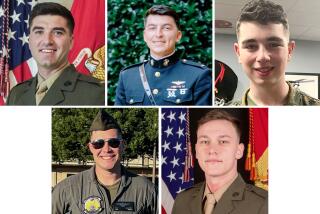U.S. Marines Ready as War Arrives With Advancing Tanks, Shellfire : Combat: Iraqi forces are engaged close at hand at Saudi border town. Sharp skirmishes go on sporadically for hours.
- Share via
EASTERN SAUDI ARABIA — It was no longer an enemy off in the distant dunes, lobbing occasional artillery shells; no longer a high-altitude Nintendo War. When illumination flares popped over the cold desert Tuesday night, U.S. Marines looked down the 30-foot-long cannon barrels of advancing Soviet-built tanks. And they heard the roar of guns.
The opening moment of the great ground war was upon them.
Never mind later assessments that this was an Iraqi reconnaissance in force, a challenge, a probe, an attempt to lure U.S. forces into Kuwait. For these first hours, the tanks and vaunted battle-hardened army of Saddam Hussein bore down, and the 1st and 2nd Marine divisions were locked in the kind of the close-in combat that is the specialty, the glory, of the corps.
“Hey diddle-diddle, straight up the middle”--the time-honored creed of the Marines.
TOW missiles, the wire-guided tank killers, exploded from light-armored vehicles in the Marine positions. Artillery roared from behind. And overhead, the ugly ducklings of the Air Force, the A-10 Thunderbolt, also known as the Warthog, raced into action alongside Cobra helicopter gunships laden with rocket pods. This moonlight night, the aircraft were not cruising the skies to kill Iraqi Scud missiles. They were defending territory miles inside friendly Saudi Arabia.
Few had anticipated that the opening battle would find the U.S. Marines and Arab troops from Saudi Arabia and Qatar on the defensive, and Hussein’s trench fighters on the move.
In the spinning, surreal black-and-white shadows, amid blinding yellow flashes of shellfire, the first dozen Marines of the Gulf War fell, and thousands more forgot all about the question that had nagged them for so long: How would they handle battle? To handle it at all left no time to think about answering questions.
Pool accounts from the front lines provided glimpses of sharp skirmishes that flared on and off for 10 hours and more, action at three points extending from the Persian Gulf coast westward to what is known as “the elbow,” where the east-west Saudi-Kuwaiti border turns north. Some of the dispatches were first-hand, some second-hand. All of them passed through military censors for approval, and all of them told a singularly one-sided story.
To begin with, the outcome never seemed in doubt. And within hours of the first encounter, Marine officers had joined their colleagues in the Air Force and Navy in expressing an almost cocky confidence in their command of the battlefield.
“We’re going to go up and spank them pretty hard, so they probably ought to call 911 right now,” said Maj. Craig Huddleston. “I expect we’re going to expel them rather violently.”
He spoke from a blocking position outside the abandoned Saudi town of Khafji, at the eastern end of the night’s actions, as Marines prepared to advance to where Iraqi troops had moved in. Huddleston called the Iraqi attack “absurd.”
By Wednesday night, though, Khafji remained a battleground. Reports from Marine positions told of smiling Saudi troops, flashing victory signs as they advanced into the town. Less than 30 minutes later, still smiling, the Saudis returned toward the rear.
Still later, there were reports that Saudi troops, supported by U.S. aircraft and heavy guns, were again fighting to clear the Iraqis out of the town.
But what must have been clear in this first significant ground battle is that no matter how much experience Iraqis could claim from their long, grinding war with Iran, this taste of American firepower was something different. President Bush had spoken of the “violence” of the high-tech American military. Now the Americans gladly displayed it.
The slow, ugly A-10 is not the glamour machine of the flight line. But with its seven-barrel 30-millimeter Gatling gun, it can spit 4,000 rounds a minute--66 a second--from huge ammunition belts into the face of advancing tanks. Cobra gunships shook the ground with the firing of anti-tank rockets. And the Marine’s TOW missiles blasted into the night sky.
It was the closest fighting of the war, surprising close at moments.
On the streets of Khafji on Wednesday, a Marine patrol searched vainly for two missing U.S. Army soldiers, who were driving through town and ended up caught in the middle of the fight.
“It was then that members of the patrol saw two BMPs, Soviet-made armored personnel carriers, and three Iraqi soldiers dressed in green uniforms practically in front of them,” according to one pool account. Both the Marines and the Iraqis seemed startled. The Marines jumped back into their Humvee jeep-like vehicles and returned to the edge of town. They checked their identification book to make sure they had really seen the enemy up close. Gunships moved in with rockets and knocked out one of the BMPs.
The two Army soldiers were listed as missing.
This article was compiled from Pentagon combat pool reports reviewed by military censors.
A LOOK AT THE 1ST MARINE DIVISION
Marines from the 1st Division played a key role in the ground clash with Iraqi forces near Khafji.
* Who: About 20,000 troops, the bulk from Camp Pendleton, make up the 1st Marine Division, the main Marine ground force in Saudi Arabia. Considered an elite fighting force.
* Headed: Commanded by Brig. Gen. James M. Myatt, who served two combat tours in Vietnam.
* What: The division, which has trained extensively in desert warfare, is backed by heavy weaponry and tanks. The troops affectionately call themselves “grunts,” a badge of honor for their role as front-line infantry.
* Gulf Role: The Marines--traveling by foot, light armored vehicles and tanks--make up the eastern flank of the allied ground forces.
* Background: In 1942, units of the division made amphibious landing on Guadalcanal, an operation that ultimately cost 3,000 casualties. During the Korean War, the 1st Division was involved in a brutal, two-week campaign in which it was outnumbered 35 to 1.
More to Read
Sign up for Essential California
The most important California stories and recommendations in your inbox every morning.
You may occasionally receive promotional content from the Los Angeles Times.













